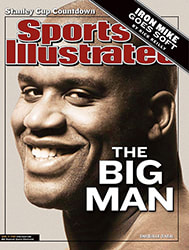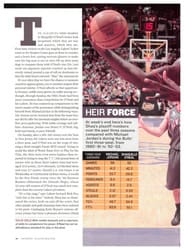
The First Families of Golf Every course architect is a branch on one of 35 design family trees. SI picked the best trees and the top 10 tracks from each
Geoffrey S. Cornish has designed hundreds of golf courses, but
his other lasting contribution to course architecture is as a
historian. His book The Architects of Golf, cowritten with Ron
Whitten, is the industry bible. Now Cornish, 87, has unveiled
the fruit of a lifetime spent researching the family trees of
golf design. As Cornish points out, course architecture is
learned not in a classroom but in the field, and going to work
for an established architect remains the primary path to
knowledge. "You have to have designed a course and then listened
to all the criticism," he says. "That is why in-house training
is the practical way to learn." Through his research Cornish has
identified 35 design lineages, reflecting hundreds of years of
apprenticeships and internships. Under the direction of Mark
Leslie, SI impaneled five experts to rank Cornish's trees: Joe
Black, past president of the PGA of America; Vinny Giles, winner
of the 1972 U.S. Amateur and founder of the agency Pros, Inc.
(now Octagon), which represents more than 20 pro golfers; Grant
Spaeth, past president of the USGA; Mark Studer, grounds
chairman at Oakmont Country Club; and Gordon Witteveen, founder
of the Canadian Golf Superintendents Association and designer of
eight courses. The panel selected the six most influential
trees, as well as the 10 best courses produced by each. Using
Golf Magazine's most recent list of the top 100 courses in the
world, SI then ranked the top six trees. As you can see, the
roots of great courses run deep.
SI's Top Six Architects' Trees
1. ROBERTSON
2. ROLLAND
3. TILLINGHAST
4. DYE
5. THOMPSON
6. FAZIO
FAMILY RANKING: NO. 4
ALICE & PETE DYE TREE
ALICE (1927- ) and PETE DYE (1925- )
Pete Dye's genius is his versatility. He deals in finesse as
easily as punishment on varied landscapes scattered across the
globe. (And don't underestimate Alice's contributions, which are
both spiritual and tangible--the island green at TPC at Sawgrass
was her idea.) No wonder Dye-sciples include minimalists like
Doak as well as men who move mountains, such as Nicklaus.
Jack Nicklaus (1940- )
Chris Cochran (1960- )
David Heatwole (1961- )
Bob Cupp (1939- )
John Fought (1954- )
Jack Nicklaus II (1961- )
Tom Pearson (1949- )
Jim Lipe (1946- )
Rick Jacobson (1958- )
Scott Miller (1956- )
Rod Whitman (1953 - )
Bobby Weed (1955- )
Chris Gray (NA)
Scot Sherman (1966- )
Chris Monti (1974- )
Lee Schmidt (1947- )
John Harbottle (1958- )
Bill Coore (1945- )
Dan Proctor (1952- )
David Axland (1961- )
Ben Crenshaw (1952- )
Tim Liddy (1953- )
Greg Norman (1955- )
David Pfaff (1939- )
Tom Doak (1961- )
Bruce Hepner (NA)
Gil Hanse (NA)
Tom Meade (NA)
Roy Dye (1929-1994)
Perry Dye (1952- )
P.B. Dye (1955- )
Brian Curley (1959- )
William Newcomb (1940- )
John Robinson (1947- )
Stephen Kay (1951- )
Scott Pool (NA)
Jason McCoy (NA)
ALICE & PETE DYE TOP 1O
1. Sand Hills (Coore and Crenshaw)
2. Pacific Dunes (Doak)
3. Harbour Town (Alice and Pete Dye and Nicklaus)
4. Muirfield Village (Nicklaus and Desmond Muirhead)
5. The Golf Club (Alice and Pete Dye)
6. TPC at Sawgrass (Alice and Pete Dye)
7. The Honors Course (Alice and Pete Dye)
8. Whistling Straits (Alice and Pete Dye)
9. Teeth of the Dog (Alice and Pete Dye)
10. Shoal Creek (Nicklaus)
FAMILY RANKING: NO. 1
ALLAN ROBERTSON Tree
ALLAN ROBERTSON (1815-1859)
Robertson, in 1858, became the first player to break 80 on the
Old Course. His influential redesign ten years earlier had
widened the fairways and created the distinctive double greens,
impressing a young protege, Old Tom Morris.
Old Tom Morris (1821-1908)
Willie Campbell (1862-1900)
Donald Ross (1872-1948)
Walter Hatch (1884-1960)
Walter Johnson Jr. (NA)
James McGovern (na-1951)
Jim Harrison (1900-1996)
Fred Garbin (1928- )
Sandy Bigler (1966- )
Eugene Wogan (1890-1957)
Philip Wogan (1918- )
George Sargent Jr. (1949- )
Henry B. Hughes (1908- )
Ellis Maples (1909-1984)
Dan Maples (1947- )
Michael Gleason (1959- )
Ed Seay (1938- )
Erik Larsen (1954- )
Harrison Minchew (1956- )
Vicki Martz (1945- )
Bob Walker (1948- )
Manuel Francis (1903-1994)
Lawrence M. Hughes (1897-1975)
Cary Bickler (1943- )
Harry Rainville (1905-1982)
Richard Watson (1932- )
David Rainville (1936- )
Jim Foulis Jr. (1870-1928)
Robert Foulis (1873-1945)
William Watson (NA)
ALLAN ROBERTSON TOP 1O
1. Old Course (Robertson)
2. Muirfield (Morris)
3. Pinehurst No. 2 (Ross)
4. Royal Dornoch (Morris)
5. Seminole (Ross)
6. Royal County Down (Morris)
7. Olympic (Watson)
8. Oakland Hills (Ross)
9. The Country Club (Campbell)
10. Lahinch (Morris)
FAMILY RANKING: NO. 6
GEORGE FAZIO Tree
GEORGE FAZIO (1912-1986)
From 1950 to '53 Fazio had three top fives at the U.S. Open, and
his sensibilities as a player informed his work, resulting in
pretty, playable courses. His nephew Tom has become a master of
aesthetics.
Jim Fazio (1942- )
Tom Fazio (1945- )
Jan Beljan (1953- )
Andrew Banfield (1949- )
Steve Burns (1958- )
Dana Fry (1962- )
Tom Marzolf (1960- )
Mike Strantz (NA)
GEORGE FAZIO TOP 1O
1. Shadow Creek (T. Fazio)
2. Jupiter Hills (G. Fazio and T. Fazio)
3. World Woods--Pine Barrens (T. Fazio)
4. Wade Hampton (T. Fazio)
5. Butler National (G. Fazio and T. Fazio)
6. Estancia (T. Fazio)
7. Champions (G. Fazio)
8. Black Diamond Ranch (T. Fazio)
9. Devil's Pulpit (Fry and Michael Hurdzan)
10. The Quarry at La Quinta (T. Fazio)
FAMILY RANKING: NO. 2
DOUGLAS ROLLAND Tree
DOUGLAS ROLLAND (1860-1914)
Twice a runner-up at the British Open, Rolland, a Scot, was one
of the longest hitters of his era, but his designs were rooted in
deception. His influence can be seen in the natural bunkering at
Pine Valley and Prairie Dunes and the illusive terrain of Royal
Melbourne.
H.S. Colt (1869-1951)
C.H. Alison (1882-1952)
Alister Mackenzie (1870-1934)
Perry Maxwell (1879-1952)
Press Maxwell (1916- )
Wiles Robert Hunter (1874-1942)
John Fleming (1896-1986)
Mike McDonagh (NA)
J.S.F. Morrison (1892-1961)
Sir Guy Campbell (1885-1960)
Sir Henry Cotton (1907-1987)
Alec Swan ( 1900-1984 )
Howard Swan (NA)
John D. Harris (1912-1977)
C.K. Cotton (1887-1974)
J.J.F. Pennink (1913-1983)
Charles Lawrie (1923-1976)
Cameron Sinclair (NA)
Donald Steel (1937- )
Tom Mackenzie (NA)
Pier Mancinelli (1920- )
Michael Wolveridge (1937- )
Peter W. Thomson (1929- )
DOUGLAS ROLLAND TOP 1O
1. Pine Valley (Colt with George Crump)
2. Cypress Point (A. Mackenzie and Hunter)
3. Royal Portrush (Colt and Morrison)
4. Augusta National (A. Mackenzie with Bobby Jones)
5. Royal Melbourne (A. Mackenzie and Alex Russell)
6. Prairie Dunes (Perry Maxwell)
7. Wentworth--West (Colt, Alison, Morrison)
8. Southern Hills (Perry Maxwell)
9. Country Club of Detroit (Colt)
10. Pasatiempo (A. Mackenzie)
FAMILY RANKING: NO. 3
A.W. TILLINGHAST Tree
A.W. TILLINGHAST (1874-1942)
A tree unto himself, Tillie was born to wealth in Philadelphia
but spent his youth running with street gangs. His path changed
when he fell in love with golf while taking lessons from Old Tom
Morris during a visit to St. Andrews. A prolific writer, Tillie
created thoughtful masterpieces defined by incomparable
bunkering.
Willard Wilkinson (1889-1979)
A.W. TILLINGHAST TOP 1O
1. San Francisco (Tillinghast)
2. Winged Foot--West (Tillinghast)
3. Baltimore--East (Tillinghast)
4. Quaker Ridge (Tillinghast)
5. Somerset Hills (Tillinghast)
6. Baltusrol--Lower (Tillinghast)
7. Winged Foot--East (Tillinghast)
8. Baltusrol--Upper (Tillinghast)
9. Bethpage--Black (Tillinghast)
10. Ridgewood (Tillinghast)
FAMILY RANKING: NO. 5
STANLEY THOMPSON Tree
STANLEY THOMPSON (1894-1952)
Born in Scotland but raised in Canada, Thompson was known as the
Toronto Terror--more for his flamboyant personality than the
scariness of his trademark bunkering. Thanks to the
globe-trotting Robert Trent Jones, Thompson's heroic
architecture was exported to the world.
Geoffrey S. Cornish (1914- )
William Robinson (1941- )
Brian Silva (1953- )
Mark Mungeam (1961- )
Howard Maurer (1958- )
Timothy Gerrish (1970- )
Robert F. Moote (1924- )
David L. Moote (1952- )
Timothy Wilton (1967- )
Clinton Robinson (1907-1989)
Douglas Carrick (1956- )
Thomas McBroom (1952- )
Ken Welton (NA)
Howard Watson (1907-1992)
Graham Cooke (1949- )
Stephen Miller (NA)
Neil Haworth (1961- )
John Watson (1933- )
Ted Baker (NA)
Norman Woods (1908-1987)
Robert Trent Jones (1906-2000)
Les Furber (1946- )
Jim Eremko (NA)
Robert Kains (NA)
Robert Trent Jones Jr. (1939- )
Gary Baird (1941- )
Jerry Martin (1939- )
Bruce Charlton (1957- )
Donald Knott (1946- )
Michael Poellot (1943- )
Mark Hollinger (1954- )
Robert Moore (1955- )
Gary Linn (1955- )
Kyle Phillips (1958- )
Mark Rathert (1953- )
Rees L. Jones (1941- )
Keith Evans (1944- )
Greg Muirhead (1961- )
Stan Gentry (1962 - )
Steve Weisser (1967- )
Cabell Robinson (1941- )
Roland Fauray (NA)
William Boswell (1961- )
Frank Duane (1921-1993)
Jay Morrish (1936- )
Tom Weiskopf (1942- )
Carter Morrish (1966- )
Roger Rulewich (1936- )
John Harvey (1963- )
Harry Bowers (1957- )
Bill Dietsch Jr. (1928- )
Ted Manning (1944- )
Ron Kirby (1932- )
Tom Johnson (1955- )
Gary Player (1935- )
Tim Freeland (1963- )
Denis Griffiths (1947- )
Rodney Wright (1951- )
Gene Bates (1947- )
Steve Durkee (1950- )
Kipp Schulties (1969- )
Tom Ross (1964- )
Steve Wolford (1957- )
Mark Galbraith (1972- )
Bob Cupp Jr. (1964- )
Fred Couples (1959- )
STANLEY THOMPSON TOP 1O
1. Highlands Links (Thompson)
2. Spyglass Hill (Robert Trent Jones)
3. St. Georges (Thompson)
4. Forest Highlands (Morrish and Weiskopf)
5. Loch Lomond (Morrish and Weiskopf)
6. Jasper Park Lodge (Thompson)
7. Peachtree (Robert Trent Jones with Bobby Jones)
8. Ocean Forest (Rees Jones)
9. Princeville (Robert Trent Jones Jr.)
10. Double Eagle (Morrish and Weiskopf)
COLOR ILLUSTRATION: ILLUSTRATIONS BY MICHAEL CUSTODE Cornish spent more than half a century researching course architect lineage.
SIX COLOR ILLUSTRATIONS: ILLUSTRATIONS BY MICHAEL CUSTODE

